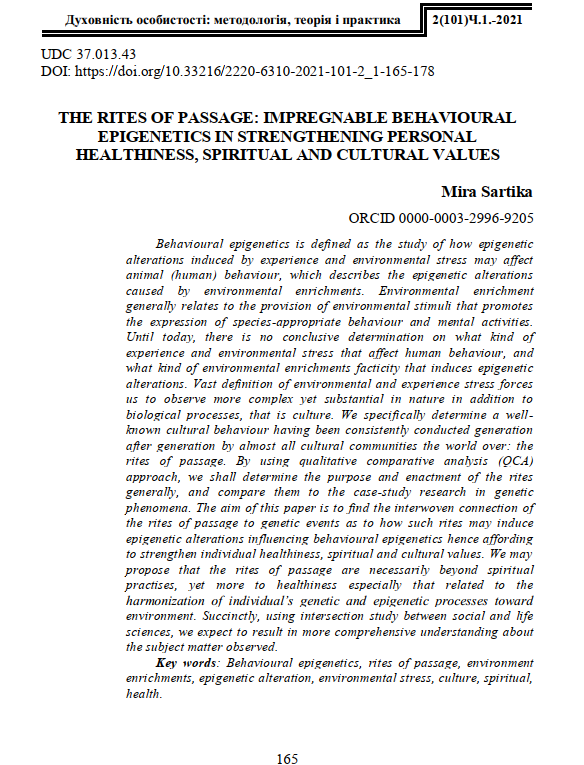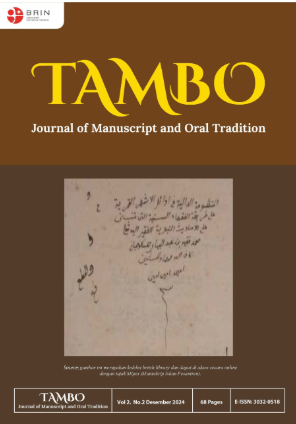Journal Publication
|
1. THE RITES OF PASSAGE: IMPREGNABLE BEHAVIOURAL EPIGENETICS IN STRENGTHENING PERSONAL HEALTHINESS, SPIRITUAL AND CULTURAL VALUES, October 2021
Conference paper: 12th International Extramural Scientific and Practical Conference Author : Mira Sartika Behavioural epigenetics is defined as the study of how epigenetic alterations induced by experience and environmental stress may affect animal (human) behaviour, which describes the epigenetic alterations caused by environmental enrichments. Environmental enrichment generally relates to the provision of environmental stimuli that promotes the expression of species-appropriate behaviour and mental activities. Until today, there is no conclusive determination on what kind of experience and environmental stress that affect human behaviour, and what kind of environmental enrichments facticity that induces epigenetic alterations. Vast definition of environmental and experience stress forces us to observe more complex yet substantial in nature in addition to biological processes, that is culture. We specifically determine a well-known cultural behaviour having been consistently conducted generation after generation by almost all cultural communities the world over: the rites of passage. By using qualitative comparative analysis (QCA) approach, we shall determine the purpose and enactment of the rites generally, and compare them to the case-study research in genetic phenomena. The aim of this paper is to find the interwoven connection of the rites of passage to genetic events as to how such rites may induce epigenetic alterations influencing behavioural epigenetics hence affording to strengthen individual healthiness, spiritual and cultural values. We may propose that the rites of passage are necessarily beyond spiritual practises, yet more to healthiness especially that related to the harmonization of individual's genetic and epigenetic processes toward environment. Succinctly, using intersection study between social and life sciences, we expect to result in more comprehensive understanding about the subject matter observed. |
|
2. Understanding the symbolic signs of temple architecture to encompass the current master plan of development of Bali, Indonesia, February 2023
Esempi di Architettura 2023, Vol. 10, n. 1 International Journal of Architecture and Engineering, Publisher: Esempi di Architettura Author : I Putu Gede Suyoga and Mira Sartika Pura is the designation of Hindu worship architecture in Bali, Indonesia. Its architectural design is a visually observable symbolic sign. Its physical existence (signifier) is in the form of spatial and building layout patterns with philosophical foundations as well as a number of abstract conceptions, but full of meanings (signifiers) that are interesting to study. This study is a qualitative study with an interpretive descriptive approach. The analysis of data and information is based on the Semiotic Theory of Roland Barthes and other theoretical conceptions that are used eclectically. The results of the study show that the term Ulon was the initial designation for a Hindu holy place in Bali before it was replaced with the terms Kahyangan and Pura until now. There are two symbolic signs in the realm of Temple Architecture in Bali, namely first, encompassing a layout or courtyard called a mandala (from one to five mandala). Second, the concept of architectural embodiment. The concept is motivated by mythological discourse and a number of architectural embodiments concepts. The myths that underlie it include: Giri 'mountain' Mahameru, Asta Aiswara 'eight powers of Gods', Sad Kertih 'six elements of welfare of life’, Dewa pratista and Atma pratista 'sthana gods and ancestral holy spirits', Elements of bhuwana agung-bhuwana alit or macrocosm-microcosm. Finally, regarding the application in the physical form of Temple Architecture, it refers to the concepts of Padma Bhuwana, Sad Winayaka, Catur Lokapala, Tri Kahyangan, Kahyangan Rwa Bhineda, and the Puser concept. In fact, today the existence and the concept of temples as a cultural heritage site, inspire the planning of a master plan for the sustainable development of Bali. |
|
3. My house my culture: the importance of traditional house in creating sustainable cities and communities for future generation, February 2023
Esempi di Architettura 2023, Vol. 10, n. 1 International Journal of Architecture and Engineering, Publisher: Esempi di Architettura Author : Mira Sartika and I Putu Gede Suyoga Annual Celebration of National Culture Week of the Republic of Indonesia in 2021 was focused on the theme of pangan, sandang, papan, those are food, clothing, shelter or house. This theme highlighted that to fulfill human basic needs in these three primary aspects, each and every society in Indonesia is being encouraged to reconnecting to their own local culture to at least recognize and cultivate the meaning of their own traditional food, clothing, and house in achieving a more sustainable society. Such theme that being implemented in Indonesia is indeed might be one of the examples of the real implementation of the Cultural Dimension of Development section article 13 on the Mexico City Declaration 1982. Nevertheless, in supporting the implementation of SDGs 11 that is Sustainable Cities and Communities, we will elaborate specifically the importance of traditional houses not only for the society but also for the environment surrounding them. Research method that we use is observation of architectural building of 12 traditional houses from 12 provinces in Indonesia. The aim of this observation is to discover the main principle of a traditional house and to discover the path to conserve as well as to transform modern architecture to follow such principle. We expect that this observation benefitted to the younger generation to apprehend the importance of a traditional house and move them to preserve their traditional house and applied the principle of those traditional houses in building modern architecture in achieving not only more sustainable cities but also strong identity, modest, eco-friendly and community-based society. |
|
4. Myths, Architecture, and Rites: The Concept of Conservation of the Tri Danu Area in Bali in the Contemporary Struggle, June 2023
In book: River Conservation and Water Resource Management Author : I Putu Gede Suyoga, Ni Ketut Ayu Juliasih, Mira Sartika The Tri Danu area (Lake Beratan, Buyan, and Tamblingan) has mythical stories, architectural physical artifacts, and periodic rites, which are an effort to conserve the sacred Tri Danu area. This study focuses on these three aspects as an individual and collective knowledge of the local community living around the Tri Danu area. The values, norms, and belief systems of the people in these myths have driven a socio-eco-religious practice that supports lake conservation programs, but is under pressure from today’s market ideology. This study is a qualitative study with an interpretive descriptive approach. The analysis of data and information is based on Pierre Bourdieu’s theory of generative structuralism and other theoretical conceptions that are used eclectically. The results of the study show that a number of knowledge in the context of preserving the ecology of Tri Danu are wrapped in mystical and magical stories. The mythology is the episteme of the local community which underlies the way of thinking, speaking, and behaving toward the sacred area of the temple and the radius of lake conservation. The socio-religious approach in an effort to preserve the Tri Danu conservation area is under pressure in various aspects of life. The struggles in the realm of today’s life are categorized into conservative, progressive, and adaptive groups. The three perspectives are based on ecological ideology, market ideology, and sustainability ideology. The mechanism of compromise and normalization is an adaptive and solution option for the middle way of sustainable preservation of the Tri Danu function. Community praxis occurs in a socio-economic-ecological pattern. |
|
5. The sacred and heritage landscapes of Bali, Indonesia: Prospectus for SDGs (2025)
I Putu Gede Suyoga[1] and Mira Sartika[2] Abstract The mountain is a sacred mandala where temples of worship for the Balinese are built. This study aims to unravel the philosophical concepts that underlie various worship temple buildings on mountain peaks in Bali, and reveal the struggles of conservative and progressive interests in the present era. This study is qualitative research with an interpretive descriptive method. Primary data was obtained from informants who were determined purposely. Secondary data was obtained from various library sources. The data were analyzed with the theoretical basis of Roland Barthes' Semiotics. The results of the study show a reading of the existence of temples built on mountain peaks spread across the island of Bali, designed based on the concepts of rwa bhineda, catur lokapala, sad winayaka, and padma bhuwana. The sacred mountain mandala, the locus of the establishment of these various temples, whether they have the status of Pura Kahyangan Jagat, Sad Kahyangan, Kahyangan Tiga, Pura Swagina, and Pura Kawitan, remains a top priority in determining Bali's sustainable development strategy. Especially, it relates to determine a suitable pattern of the development of activities and facilities, in order to maintain the sacredness of the sacred radius of such sacred mandala. Keywords: mountain, holy mandala, worship architecture, sustainable development strategy, Bali [1] Bali Institute of Design and Business, Denpasar, Indonesia pgsuyoga@gmail.com [2] Chakra Cultural Foundation, Jakarta, Indonesia mirasartika.edu@gmail.com |
|
6. Ritual Kehamilan, Kelahiran dan Akil Balig di Desa Nyalindung, Kabupaten Bandung Barat sebagai Faktor Epigenetika Perilaku Sunda (2024)
Mira Sartika, Isabela Andhika Paramita dan Hernandi Tismana ABSTRACT Rites of passages during pregnancy, birth, and adolescent, can serve as frameworks for behavioural epigenetics. The purpose of this study is to document rites of passages as oral traditions in Nyalindung Village, West Bandung Regency, West Java, and analyse the elements involved according to epigenetic perspectives. We documented three rites of passage during pregnancy, one rite of passage during childbirth, and two rites of passage in adolescence. Positive parental and social support for children in the community as a prominent factor of behavioural epigenetics were observed from the traditions. Epigenetic changes and brain development are most critical during childhood. Sufficient and positive external stimulation in the form of ceremonial rites and prayers during this time can influence the physiological and psychological health outcome of an individual in later life. Keywords: rites of passage, behavioral epigenetics, childhood, adolescence, West Bandung. |





